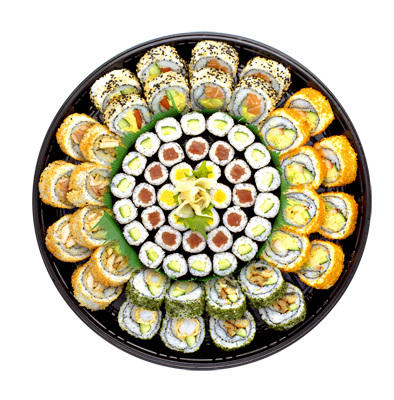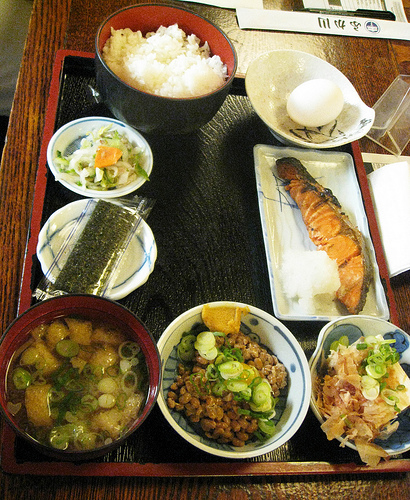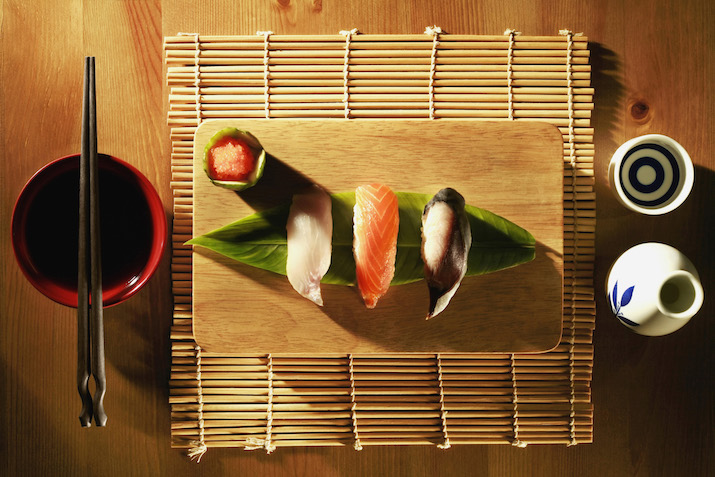Japanese people aren’t fat. So that makes sushi, and Japanese food, good healthy food, right?

American Sushi
The Japanese are arguably one of the healthiest societies on earth. They pretty much blow the US out of the water in terms of life expectancy (86 years in Japanese women versus 80 years in Americans) and at 3%, they boast the lowest obesity rate in the world (the US rate is ELEVEN TIMES that! No wonder we need so much help in dieting!) So logically, you would think that a night out for some sushi or ramen might have a beneficial effect on those abs you’ve been cultivating all winter long.
Well, I’m here to tell you to proceed with caution, if you want to stick to your diet and fitness goals! And here’s the simple reason why:

Japanese Sushi
While we Americans are busy guzzling down platters of California rolls, the Japanese stay slim by diversifying their diets. Most of us hear Japanese food and immediately envision heaps of white rice, but the Japanese dinner table is actually much more colorful. The reason this diet has been associated with keeping fit is because it includes soy products (tofu, edamame, miso), fruits, fatty fishes full of omega-3s (salmon, tuna, mackerel, sardines, herring, etc. ), and VEGGIES! Seriously, the Japanese manage to sneak those leafy greens into everything… even breakfast! So if you want to authenticate your sushi experience, try taking some tips from our pals across the Pacific.
Portion control
While it sometimes seems like we are programmed to value quantity over quality, it is possible to feel satisfaction on smaller amounts of food. The Japanese seem to consume massive quantities of rice, and while they do eat it at practically very meal, it is eaten in relatively small amounts and used as a filler to prevent binging on junk. Meanwhile, most of us are completely oblivious to the rice content of sushi. Well, newsflash: each sushi roll contains about ½ cup of rice at around 120 calories. This means that a mere 3 rolls clocks in at almost 400 cals in rice alone! This doesn’t even include whatever crispy fish or spicy mayo you add into the mix. So do yourself a favor and prevent rice overload by minimizing your portions. Try ordering half of your food to-go, or choose a restaurant that serves food on smaller plates. Research shows that tinier plates can actually induce smaller appetites!
Diversity
This is the secret to less fat/cals and more nutrients! Instead of feasting on your own personal rice bowl, order multiple dishes and share. Fill up on lower cal dishes like appetizers, salads, or steamed veggies. Clear broth soups (miso), seaweed or daikon salads, gyoza (vegetable dumplings), or agedashi tofu are all excellent choices. Edamame is a classic favorite that is also crazy high in protein and fiber (9 grams fiber and 11 grams protein in 1 cup.) You can also try adding small vegetable plates, like miso eggplant, to your meal. And never order rice and noodles in the same sitting (it’s bad luck!)
Simplicity
In Japan, sushi = rice + fish + seaweed + several drops of soy sauce. There are no Philadelphia rolls or Red Dragons or Double Crunchies (though, I have seen hamburger sushi and it is definitely NOT recommended.) So take a tip from the experts and avoid the fancy stuff. Sashimi is your best bet at 40-60 cals a piece. If you’re into the rolls, you will want to stay away from anything with crunchy, spicy mayo, or special sauce in the title. That stuff will put your fat and calories through the roof!
Spicy mayo adds an additional 100 cals and 11 grams of fat per tablespoon. And watch out for that ginger carrot dressing! Sadly, it’s equally as fattening.
So the Japanese seem to have it pretty much figured out, but there are a couple of things you can do to make sushi just that much better:
1. Cut back on sodium
This food is notoriously high in the stuff. While it’s recommended that you keep your daily intake at less than 2500mg, there are upwards of 1000mg in only one tablespoon of soy sauce. Other high sodium foods common in Japanese cooking include teriyaki sauce, pickled foods, smoked fish, and miso (1 cup miso soup has about 650mg.) So choose low-sodium products whenever possible, which typically have about half the salt.
2. Up the fiber
While white rice is basically all carbs, brown rice also contributes some protein, fiber, and a small amount of healthy fat to your meal. It is also high in essential nutrients like manganese, magnesium, and zinc.




